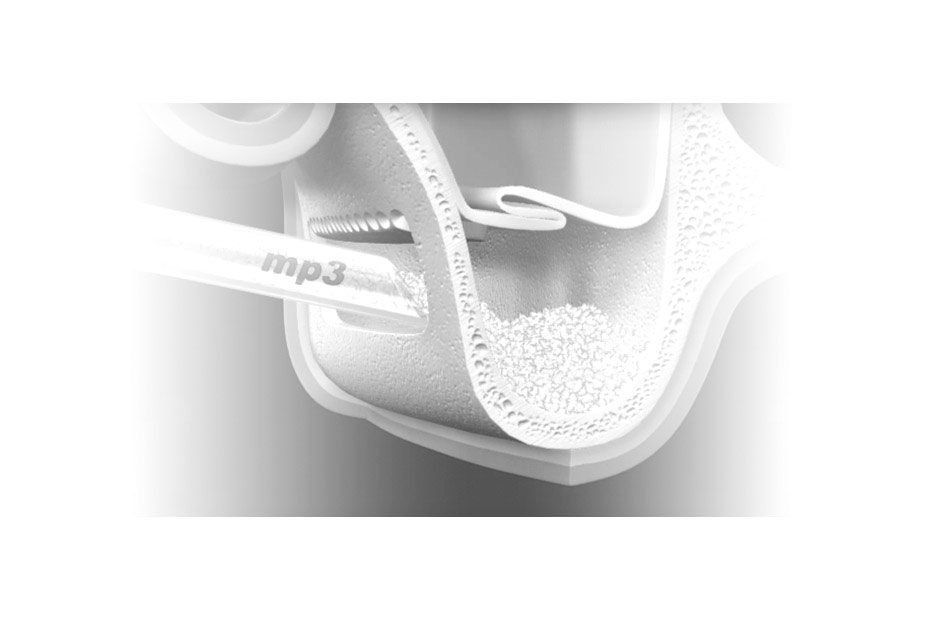
JAW RECONSTRUCTION AND BONE GRAFTING
The extraction of one or more teeth causes a atrophy (loss) of the supporting bone. It is often necessary to recreate this lost volume of bone before the insertion of a dental implant. An exhaustive examination of your mouth combined with a 3-dimensional radiological analysis will determine if a bone graft is needed.
Several techniques and materials can be used depending on the site to be grafted, the volume to be regenerated and the medical / personnal needs particular to the patient. The surgeons at the Maxillo-Mauricie Clinic are more likely to opt for a synthetic bone graft material to avoid the discomfort of a donor site. They can also maximize the results of bone grafts by adding autogenous growth factors collected via blood.
However, it is sometimes necessary to use a bone graft taken from the patient. When necessary, the surgeons of the Maxillo-Mauricie Clinic are qualified to perform all of these bone harvests.
It should be noted that bone grafts can be covered (paid) by the Régie de l’assurance maladie du Québec when they are performed in a hospital center. The surgeons of the Maxillo-Mauricie Clinic are all active members of CIUSSS-MCQ hospitals.
Finally, it should be noted that the surgeons of the Maxillo-Mauricie Clinic tend to minimize the use of bone grafts through the use of innovative design implants and minimally invasive techniques. This is not only to reduce the discomfort of surgery but also to maximize the chances of successful treatment by eliminating the risk of complications due to the bone grafting procedures.
ORTHOGNATHIC SURGERY
When the teeth do not close perfectly together, we talk about malocclusion. There are two types of malocclusion. The first type is when the teeth are not well aligned on the jaws. This is a purely dental malocclusion. This disorder is treated only with orthodontic appliances, removable or not, made by an orthodontist or a dentist. The second type is when not only the teeth are not aligned well on the jaws, but when also the jaws are not well aligned with each other. This is a dento-skeletal malocclusion. The lower jaw (mandible) can sometimes be retracted from the upper jaw (maxillary). In this case, it is a class II malocclusion (retrognatism). When the mandible is advanced relative to the maxillary, it is a class III malocclusion (prognatism). In order to correct the dento-skeletal malocclusions, a combined orthodontic and surgical treatment of aligning the jaws is necessary. The surgical procedure is called orthognathic surgery.
In order to correct misalignment of the jaws and improve the patient’s profile and occlusion, several types of surgeries exist. These include maxillary surgery (LeFort I osteotomy), surgically-assisted rapid palatal expansion surgery (SARPE), mandibular surgery (bilateral sagittal split also mandibular osteotomy (BSSO)) and chin surgery (genioplasty). ). Orthognathic surgery is part of the treatment modalities for sleep apnea. When a combined orthodontic and orthognathic surgery is required, the orthodontist or treating dentist must first align the teeth on the jaws, then the maxillofacial surgeon can proceed with the necessary surgical procedures to correct the patient’s malocclusion.
Surgery consisting of aligning the jaws is performed under general anesthesia in hospital. Following an observation period, patients may leave the hospital the next day or two days after their intervention. Right out of the operating room, the jaws are guided in their new way of closing together with elastics. The jaws are no longer fixed together rigidly with metal wires. Patients must adhere to a soft diet during the recovery period. They are followed by the surgeon as well as the orthodontist or dentist throughout the healing period.
TRAUMATOLOGY
Treatment of fractures involving the face.
The procedure is usually performed under general anesthesia, in a hospital center.
Depending on the extension of the procedure, hospitalization is sometimes necessary (one to two days).
MAXILLOFACIAL PATHOLOGY (TUMORS AND CYSTS)
Treatment of lesions (abnormal tissue appearance) involving the jaws and gums. The procedure is usually performed under general anesthesia, in a hospital center.
Hospitalization is rarely necessary. It is therefore a one day surgery. Small lesions are treated very well under local anesthesia (with or without conscious sedation) at the clinic.
TEMPOROMANDIBULAR DISORDERS
Treatment of disorders of the joint of the jaw, as well as muscles and ligaments which surround it. In some cases, intervention under general anesthesia or conscious sedation should be considered. It then takes place in the operating room, in a hospital center.
Hospitalization is rarely necessary. The patient then returns home the day of the intervention, if the circumstances allow.
ORO-FACIAL PAIN
Pain associated with hard and soft tissues of the head, face and all intraoral structures. The necessary treatment is very variable and may include, as the case may be, a change in lifestyle, pharmacological treatment (medication), surgery …
